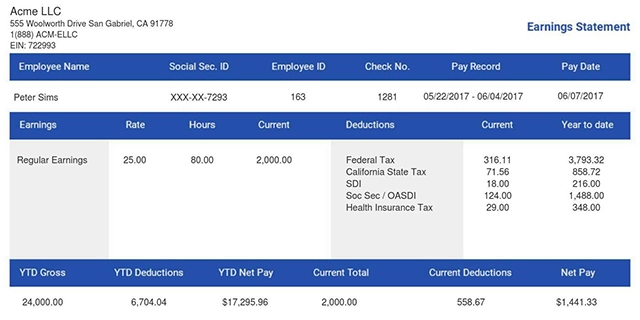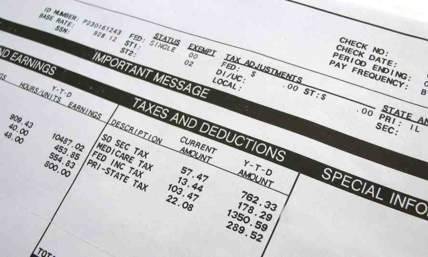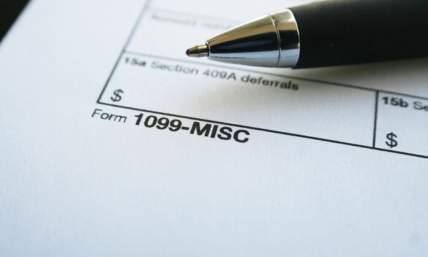10 Things You’ll Need from Each Employee to Achieve Efficient Payroll Processing
Running payroll isn’t that complicated at face value. But unfortunately, there’s quite a lot more to payroll than just doing some arithmetic and writing a check.
If you own a small business, you very well might be trying to do payroll processing on your own, or perhaps combined with the help of accounting or bookkeeping software.
Even if you sub-contract payroll services, it helps to understand the basics. I learned a lot by messing up my small business’s payroll and then correcting the mistakes I made.
I’ll show you the ten things you need from each of your employees for payroll processing to be done right.
- Getting Started: Eight Steps for Processing Payroll
- 10 Things You’ll Need from Each Employee to Process Payroll
- Ten Essential Employee Records for Payroll Processing
- Payroll Terms: A Glossary
- Small Business Owners Obligations
- Why Is Payroll Processing Important?
- Steps to Take If You Struggle with Cash Flow at Payroll Time
- FAQ
- Running Payroll Yourself to Pay Employees
- Common IRS Payroll-Related Forms
- Payroll Processing Bottom line
Getting Started: Eight Steps for Processing Payroll
Following these eight steps will set you in the right direction when it comes to your small business payroll needs. Notice that as soon as you have a payroll system in concept, your next vital task is to collect the required information from your employees.
- Select a System for Payroll Processing
- Draft and Finalize a Policy
- Collect Employee Information
- Decide on Direct Deposits or Paper Checks
- Setup your Recordkeeping and Hours Tracking
- Collect Timesheets
- Approve and Issue Payroll
- Reporting, Updating, and Staying Legal

10 Things You’ll Need from Each Employee to Process Payroll
When it’s time for payroll processing, you will rely on the totality of your system. But, you or your payroll provider will be dead in the water without having all employee information on file. Your business should collect and document these ten things for each employee. They’re all essential for proper payroll processing.
Essential Payroll Records to Gather from Employees
- Complete and Accurate Job Application
- Properly Filled-out IRS W-4 Form
- State Withholding Application
- I-9 to Verify Work Authorization
- Direct Deposit and Banking Information
- Forms for Medical Insurance
- Retirement Funding Documents
- Union Contracts and Documentation
- Business-Specific Contracts
- Internal Organizations Documents

Ten Essential Employee Records for Payroll Processing
Let’s look at each one of these specific items more in-depth.
1. Obtain a Complete and Accurate Job Application
Anytime you are onboarding a new employee, they should file a complete and accurate employment application.
This application filing might seem like something you could skip, especially since you’re going to also receive a W-4 with much of the same information from a new employee. But, it’s essential that you maintain records of all the applications you receive for new hires as well as those who don’t make the grade.
This simple document will, of course, provide you with essential information about your employee, like their address, full legal name, and birthdate. But, keeping these records will also help protect you and your company from claims of discriminatory or unscrupulous hiring practices.
You’ll have the paperwork to support your hiring decisions. For instance, if you don’t hire a candidate who claims discrimination, you can reference their rejected application and explain why you ultimately hired someone else instead of them.
Preserving these applications will also give you a quick reference of past applicants in case you decide to hire them in the future.

2. Get and Submit a Properly Filled-out IRS W-4 Form
As we know from the old saying that, ‘nothing is certain, but for death and taxes,’ the Internal Revenue Service (IRS) is not an organization you should trifle with. The IRS is responsible for not only tax revenue collection but the enforcement of federal tax law.
The last thing any small business needs or wants is to run afoul of the IRS. The penalties can be quite severe and potentially include not only making good on paying back taxes but paying fines and serving potential prison time as well.
So, remember that A W-4 form is an essential tax form, also called an Employee’s Withholding Allowance Certificate.
Without filed tax forms on record for employees, you cannot determine their tax filing status or any allowances they claim. That makes it impossible to withhold federal income tax, leaving you unable to pay your employee. Attempts to circumvent this are illegal.
You need to collect a complete W-4 from each employee so that, as their employer, you can accurately withhold the correct federal income tax from their pay when you are processing payroll. Consider asking your employees to update their W-4 each year, and require it whenever their personal or financial situation changes.
Be sure to report any new hires to the IRS each pay period.
3. State Withholding Application
As an employer, you have to withhold state and local taxes in addition to federal taxes. Knowing how much to withhold is your responsibility, so the IRS offers what they call the Employer’s Supplemental Tax Guide. You’ll also need to understand the state and local taxes where you operate your business.
As you can see, paying employees requires a comprehensive approach to payroll processing. Small business owners must keep track of state payroll taxes, federal income tax, calculating payroll and net pay for each employee.
That’s why most business owners consider outsourcing payroll. They still have to do some work to collect the tax forms necessary to set up payroll for their employees, and they may still utilize some payroll software to maintain their awareness of the payroll process.
But, their payroll company handles the employee pay checks and payroll records. That same payroll service provides documentation to the employer, allowing them to maintain a complete database of employee information like pay stubs, tax forms, and other records.
If outsourcing payroll services is something you're more interested in learning about then please do not hesitate to check out our paystub generator software.

4. Use an I-9 to Verify Work Authorization
IRS Form I-9 is another required tax document. Its purpose is to document that every new employee is authorized to work in the United States. At the time of their hire, each employee must complete this form. Employers are required to ensure that the employee’s portion of the form is completed properly and in a timely fashion.
Then, the employer must complete a second section, documenting their examination of the provided identity and work authorization documentation. Employers are required to retain all completed Form I-9s for at least three years after the date of an employee’s hiring, or for one year after the date of their employment termination.
5. Direct Deposit Information
Direct deposits are increasingly common. There are still some misconceptions about how they work and how easy they are, but they are fast, convenient, and the preferred choice of many employers, payroll services, and employees.
Setting up direct deposit is easy, and payroll software or your contracted payroll provider can help you obtain and file each employee’s direct deposit information. After manually processing payroll yourself or through the payroll software or service, employee pay checks will hit their bank accounts.
Both you and the employee will receive pay stubs for each pay period. These pay stubs will show how you calculated net pay, income taxes, state taxes where applicable, and any other payroll deductions.
Running payroll requires you to do a lot more than just track employee hours. To effectively manage payroll, you should consider using a payroll service. And, you should strongly consider issuing all employee pay checks as direct deposits.
It’s not only a convenient way to pay employees, but it’s much more secure than paper checks.

6. Medical Insurance Forms
If you offer your employees medical insurance, you will need to have all of their enrolment forms prepared prior to running their payroll. Otherwise, you won’t know how much to deduct from their gross pay.
As the employer, you need to have a firm grasp on all this documentation. Otherwise, you risk having to make more complicated adjustments than necessary.
7. Retirement Funding Documents
Suppose you have a pension plan or other retirement fund on offer to your employees. In that case, you need to make sure that there is a complete set of documents that explains the fund to your employees and accurately details their contributions per pay period and any matching done by your business.
All of these deductions, including employee benefits, retirement, social security, and your business’s contributions, appear as line items on each pay stub in each pay period. Some may be pre-tax, while others are post-tax, depending on the exact benefit and surrounding laws.

8. Union Contracts and Documentation
If you run a business with unionized employees, you need to document and understand their enrolment and any dues deducted from their gross pay. An employee’s net pay will look very different from their gross, so it’s extremely important to collect and maintain accurate documentation.
9. Contracts, Clauses, and Additional Documents
Consider also that some businesses need to have non-competition, intellectual property clauses, or non-disclosure contracts on file for each employee. For large companies, that is within the purview of a Human Resources department.
That might mean more work for the owner for a small business, even if processing payroll is outsourced.
10. Internal Organizations Documents
Each company, whether a small business or an international conglomerate, has a payroll schedule. They also all have internal paperwork tailored to the type of business they do.
For instance, some businesses have their employees sign contracts regarding the term of employment, employee benefits, the pay schedule, the employee’s hourly wage, overtime pay, and even any health savings accounts available.

Payroll Terms: A Glossary
Keep this glossary handy so you can refer to it whenever you are handling payroll. If any question arise, first refer to list!
Payroll Taxes
Payroll taxes are an umbrella term for all of the taxes paid by the employer. The tax liability for a business is the total of all the employer taxes due, plus the taxes withheld on behalf of your employees.
So, for federal taxes, that means FICA (social security and Medicare) and FUTA (unemployment). As the employer, you’re responsible for paying the tax liability, and right now, that means paying the combined FICA tax rate of 7.65% (for your business and your employee) and another 5.4-6% for FUTA.
Taxes withheld and paid on your employees’ behalf will vary, due to deductions, filing, and marital status, based on their W-4.
To better understand exactly what your liability is in terms of payroll taxes, the IRS offers a worksheet called IRS Publication 15-T.
You’ll also have to determine your state and local tax liabilities separately by using their respective tax codes in your location. We also have a dedicated blog post that goes into depth on payroll taxes, as well as its differences between income tax.

Payroll System
A payroll system is the entire process and policies by which a company or organization will set up payroll and pay its employees.
At its most basic, a payroll system calculates gross salary, then deducts and withholds all the taxes, arriving at the net pay for the employee.
In reality, it’s a bit more complicated than that. Here are some broad concepts to remember when discussing payroll systems.
- Set pay policy, including benefits
- Define components of pay, like base salary, variable pay, and travel allowance
- Gather payroll information, like uniform or cafeteria expenses
- Calculate gross salary
- Perform deductions and withholding calculations determining net pay
- Pay the employee
- Pay all tax liabilities
- Perform all filings
Pay Period
A pay period is the time when an employee performs work for the company. For instance, if the employee worked from September 16th to September 30th, that’s the pay period. Payday is the day when checks are issued.
Regardless of your pay period or the frequency of your payments (called a pay cycle), your business is required to meet government deadlines. Typically, federal and state taxes are due monthly, and unemployment tax is due at least quarterly.
Payroll Schedule
The majority of businesses pay employees on a regular schedule, with monthly, bi-monthly, or weekly pay periods being the most common. The federal government does not regulate when you run payroll, but you must be consistent and remain in constant compliance with the Fair Labour Standards Act.
Once you pick a payroll schedule, stick to it! It’s a good practice to maintain two to three weeks’ worth of payroll cash on hand at all times. This way, temporary cash flow problems won’t necessarily have an immediate effect on your ability to run payroll and pay your workers.

Employee’s Gross Pay
An employee’s gross pay refers to the total amount of money they earned in a given pay period.
Employee’s Net Pay
An employee’s net pay is the remaining balance after deducting social security, unemployment taxes, Medicare taxes, federal income taxes, and any additional expenses from their gross pay.
Payroll Provider
A payroll provider manages the payroll system for a business. They process payroll, preserve and disseminate payroll records, calculate gross pay and net pay, and even pay your employees.
Many payroll providers offer a comprehensive payroll solution. Or, you can opt to do some of the work in-house.
Employer Identification Number
An Employer Identification Number (EIN) is sort of like a business’s version of a social security number. An EIN is sometimes also known as a Federal Tax Identification Number (FTIN or TIN). It identifies a business entity, and most businesses, even charities, need one.
Applying for an Employer Identification Number
You can very quickly and easily apply for an EIN online for free. To begin, your principal business must have a location in the United States or its territories, and the applicant must have a valid social security number (SSN), Individual Taxpayer Identification Number (ITIN), or an existing EIN.
Federal Unemployment Tax
Collectively, federal unemployment taxes are also known as FUTA, as they are mandated by the Federal Unemployment Tax Act, hence the acronym. Most employers will pay both a federal and a state unemployment tax when they process payroll.
Remember, this is not deducted from employee wages. This is a cost borne by the business.
IRS Form 940 and its instruction sheet both contain more information regarding FUTA.

Income Taxes
Income taxes are the taxes levied on businesses and individuals who earn income or profit. In the United States, there are taxes at the federal level, and most states have codified their own income tax statutes as well.
There are some individual states that do not require income tax.
Federal Insurance Contributions Act
FICA, or the US Federal Insurance Contributions Act (FICA), is an umbrella term that refers to all taxes relating to social security and Medicare taxes. Different rates apply for each.
Right now, the numbers look like this.
- Employer FICA tax rate: 6.2%
- Employee FICA tax rate: 6.2%
- Employer Medicare tax rate: 1.45%
- Employee Medicare tax rate: 1.45%
When the employee’s and employer’s contributions are combined, the effective tax rate is 12.4% for FICA taxes and 2.9% for Medicare taxes. But, some employment, like agricultural work, is taxed differently.
There are also wage-based limits on social security contributions and additional Medicare tax withholding rates for certain earners. You have to maintain awareness of all the different thresholds and requirements each time you are processing payroll.

Medicare Taxes and Social Security
Social security taxes are the collective taxes levied that relate to old-age, survivor, and disability insurance benefits. Medicare covers all sorts of expenses related to medical care, but it is sometimes referred to as the hospital insurance tax. They have different rates, even though they are all part of FICA.
Health Savings Account
A Health Savings Account (HSA) allows you to set aside pre-tax earnings for future payments of qualified medical expenses. You may be able to bring down your overall healthcare costs by paying coinsurance, co-payments, deductibles, and some other expenses using HSAs. But, those funds are typically not eligible for paying healthcare premiums.
There are also strict rules about who can use HSAs, how much you can contribute, and minimum deductibles. One bonus is that unused HSA funds earn interest and roll over from one year to the next, always remaining tax-free.
Small Business Owners Obligations
The federal tax authority is no joke. It’s a business owner’s legal obligation to pay taxes, just like their employees. Withholding for social security and Medicare is done under your employer tax ID, so any mistakes can come back to haunt you.
That’s why the decision to manually process payroll is a risky one. For most businesses, it makes more practical sense to have an outside entity run payroll and tell you when to pay payroll taxes and how much you owe.
Tax deadlines are always looming, so if you want to focus on running your business and keeping your customers happy, you probably can’t afford to spend your time distracted by paying employees. It’s just far too complicated, and there is an awful lot of liability associated with designing and maintaining a payroll process in-house.
Even just managing payroll records can be a massive undertaking. It takes a lot more than a check book to run payroll and pay workers.

Why Is Payroll Processing Important?
Payroll processing is not just a way to file payroll taxes and pay your employees. When done right, running payroll will ensure that you comply with the laws and regulations set forth by the IRS and the Department of Labour, in addition to those set by your state and local governments.
Steps to Take If You Struggle with Cash Flow at Payroll Time
Short-term cash flow problems are a headache. When you have a payroll run coming up, and you lack the funds to cut checks for your employees, you’re on the verge of insolvency. Without taking aggressive action, things can quickly spiral out of control.
Consider taking the following emergency measures to address your payroll shortfall. Then you can strategize for solutions to address the wider issues your business faces.
- If you have inventory, sell it as fast as you can. Doing so, even at a loss, will provide you a quick infusion of cash to make payroll.
- Address any past-due accounts aggressively. You can utilize a collections company, but that takes time. Consider picking up your phone and reaching out directly to your clients with outstanding past-due balances.
- Contact your bank and request a business line of credit. Or, speak to your accountant about withdrawing funds from any of your retirement accounts. You may get hit with a bit of a tax penalty, but that’s better than insolvency and potential bankruptcy.
- Sell unnecessary equipment or personal items. If you have an extra truck, a disused machine, or even a satellite office, a quick sale can pump life back into your business and help you meet payroll demands.
- Offer incentives to clients to pay now. There’s no reason you can’t offer a modest discount for payments received early.
Perhaps the single most important thing for you to keep in mind is that you need to communicate with your employees.
It’s quite possible that if you struggle to meet payroll, some employees may want to quit. You may even have to let some of them go. By keeping the lines of communication open, you may be able to preserve your relationships and your business. Otherwise, you may have a potential mutiny on your hands that could have a further deleterious effect on your business.
FAQ
Let’s answer some frequently asked payroll questions.
Does My Business Need to Run Payroll?
If you plan on paying employees, the short answer is yes. Some employment classifications, such as independent contractors, file their own taxes, freeing you from the need to perform withholding. But, you will still be required to report income and perform every required tax filing.
Even for a business that doesn’t have any employees, it makes a lot of sense to out-contract a payroll solution to set up payroll, pay your employees, and meet all of the government’s requirements.

As an Employer, Can I Fill out a W-4 for My Employee?
No. You’re also not permitted to give an employee direct tax advice, though you can and should explain the form to them if they don’t understand it.
The IRS website is the best resource for finding both official forms and reference documents that will help both you and your employee understand them.
What Information Needs to Appear on a Paystub?
Each pay stub should include all of the following information at a minimum.
- Gross pay
- Time Worked
- Overtime Pay
- Benefit Contributions & Reimbursements
- Any additional income
- Net pay
What Is Gross Pay?
An employee’s gross pay represents the total amount of money they are due in a pay period. After you process payroll and calculate the employee’s net pay, you know how much to pay your employees.
How Do You Calculate Gross Pay?
To calculate the gross pay of hourly employees, simply multiply the hours worked by their hourly wage.
For instance, let’s say an employee earns an hourly wage of twenty dollars. At the end of their pay period, they worked sixty hours. Sixty hours times twenty dollars per hour is $1200, their gross pay.
Then, whether you’re processing payroll manually, with payroll software, or through payroll services, you will calculate their net pay after withholding state and federal taxes and any other necessary employee payments.
What About Overtime Pay?
Calculate overtime pay increases into each pay period. They are still subject to income tax, and when you process payroll, it’s your job as the employer to withhold income taxes.
Remember that many employees are entitled to overtime pay as codified in the Fair Labour Standards Act (FLSA). You also need to display the official FLSA poster and retain fourteen points of information for each non-exempt worker.
What are the fourteen required records? FLSA recordkeeping requirements include:
- Full name and the social security number of the employee
- Their address, including local zip code
- Their birthdate
- Their occupation and sex
- Time and day of the week when the employee begins work
- Total hours worked each day
- Total weekly working hours
- Determination of employee wages ($1,000 per week, $14 per hour, et cetera)
- Regular hourly pay rate
- Total straight-time earnings
- Total overtime earnings by workweek
- All additions to or deductions from wages
- Total wages per pay period
- Date of each individual payment and the pay period it covers
Retain all of these records for at least three years. Time cards are eligible for destruction after just two years. They are subject to inspection by the Department of Labour. Consider using digital storage and a proper backup to avoid potential loss or accidental destruction.

How Do You Calculate Net Pay?
Calculating net pay for your employees is part of the payroll process. You will have to withhold federal, state, and local taxes. Your local government and your state’s department of labour are the best resources for the applicable tax liabilities in your locale. The federal government offers a tax guide to help make things easier.
But you still need to do a bit more work to calculate net pay. Now, you need to subtract all deductions, as well as every withholding from their gross earnings, including health care premiums, retirement contributions, child support garnishments, and all else that may apply.
For instance, if you offer stock purchasing options or access to a health savings account, those funds are deducted from gross pay as pre-tax earnings.
That takes care of pre-tax deductions and withholdings. But there are some post-tax deductions that may still apply, like union dues, insurance plans, and 401(k) contributions).
Finally, you have arrived at your employee’s net pay, and you are ready to distribute earning statements, pay stubs, and pay checks to pay your employees. Don’t forget to complete file payroll taxes in a timely manner.
Running Payroll Yourself to Pay Employees
If you decide to shoulder the burden of doing payroll yourself, this guide has armed you with a lot of the facts. You will assume all the responsibility for complying with all legal obligations and reporting compliance.
It’s a very good idea to at least consult with an accountant or a payroll expert to make sure you completely understand all of the ins and outs before attempting to manage your own payroll.
Once you take the leap to be your own payroll manager, be sure to keep extremely detailed and accurate payroll records. While ignorance of the law will not be a valid excuse if you make a mistake, doing so can help you sort out the mess and provide a relevant demonstration of your good intentions.
Always be mindful of mistakes and take immediate corrective action.
For better ways to manage payroll in your business please check out our blog post.
Common IRS Payroll-Related Forms
This collection of forms are quite common, and they all relate to payroll and tax filing. For detailed information on each and in-depth instructions on how to fill them out, utilize the IRS website.
- Request for TIN and Certification: Form W-9
- Employment Eligibility: Form I-9
- Worker Status for Purposes of Federal Employment Taxes, Income Tax Withholding: Form SS-8
- Employee Withholding Certificate: Form W-4
- Wage and Tax Statement: Form W-2
- Employer’s Annual Unemployment (FUTA) Return: Form 940
- Quarterly Federal Tax Return (Employer): Form 941
Also read: Do You Need Multiple W2 Forms From The Same Employer?
Payroll Processing Bottom line
Setting up, managing, and actually issuing payroll isn’t easy. It’s one of the most fundamental and essential things a business has to do, and it comes along with all sorts of regulatory burdens, potential headaches, and risks.
For most businesses, payroll is not something to do in-house. The smaller your business is, the more tempting it might be to try and avoid the expense of an outside payroll company. But, if you run astray of the IRS, your short-term savings will likely pale in comparison to the fines and penalties you potentially receive as a result.
If you do decide to do it all yourself, be extremely careful, and educate yourself on all the aspects of labour laws, federal tax codes, and all of the applicable local and state regulations and tax liabilities.
It’s pretty likely that once you start reading through all of the requirements, you’ll be looking for a payroll services advisor to help. Don’t hesitate to find out more about comprehensive payroll solutions today.















